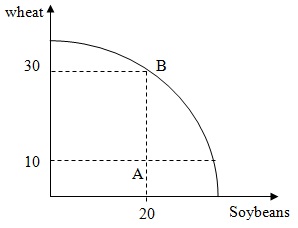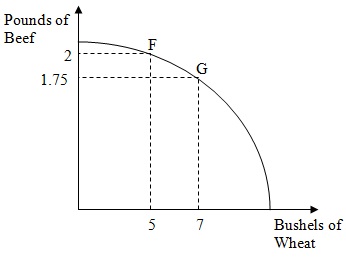I. Concepts:
Opportunity cost
Production Possibilities Frontiers (PPF)
Absolute advantage
Comparative advantage
II. Questions:
Problem 1: The resource cost to produce fish and oil are listed below.
Fish Oil
Britain 30 10
Norway 60 30
Notice that the numbers in the table represent units of resource required to produce one ton of either fish or oil. For instance, Britain requires 30 units of resource to produce 1 ton of fish whereas Norway requires 60 units of resource to produce 1 ton of fish. Use the information in the table to answer the following questions.
1. Assume that each country has resources fixed at 120 units during the given time period. Fill in the table below with the maximum amount of fish or oil that Britain and Norway can produce from these resources.
Fish Oil
Britain
Norway
2. What is the opportunity cost of producing 1 ton of fish in Britain?
3. What is the opportunity cost of producing 1 ton of fish in Norway?
4. Which country has an absolute advantage in the production of fish?
5. Which country has a comparative advantage in the production of fish?
6. Assume each country specializes according to its comparative advantage. If the country with the comparative advantage in fish produces 1 more ton of fish and the country without the comparative advantage in fish produces 1 less ton of fish, what will happen to total world production of oil?
Problem 2: In the next figure, assume that the economy is operating at point A. What is the opportunity cost of moving to B?
a. About 20 bushels of wheat.
b. Infinite, B cannot be produced at any cost.
c. 0.
d. About 2 bushels of soybeans.
e. About 1 bushel of wheat.

Problem 3: Use the figure below to answer the following question. Assume that the Canadian agricultural land is used either to raise cattle for beef or to grow wheat. The figure below represents the production possibility frontier for beef and wheat. Determine the opportunity cost of each pound of beef between points F and G.

Problem 4: Which of the following items will not affect an economy’s PPF?
a. The development of a better fertilizer.
b. Growth in the labor force.
c. A change in consumers’ preferences.
d. The development of a more productive method of steel production.
Problem 5: The law of increasing opportunity cost causes the PPF to have a:
a. Bowed in toward the origin shape.
b. Bowed out from the origin shape.
c. Linear shape (constant slope).
d. All of the above are possible.
e. None of the above.
Problem 6: The PPF of a country producing wheat and barley is bowed out from the origin. The shape of this PPF implies that:
a. Some resources are better suited for producing wheat than for producing barley.
b. The opportunity cost of producing more wheat falls as wheat production rises.
c. The farmer’s technology is not subject to the principle of increasing costs.
d. The opportunity cost of producing wheat is constant.
Problem 7: The law of comparative advantage explains why
a. Advanced nations will not trade with less-developed countries.
b. An advance nation will not trade with other countries.
c. Less-developed countries only trade among themselves.
d. Nations trade with each other, regardless of their relative levels of economic development.
e. Nations erect trade barriers.
Problem 8: Sarah and James are siblings. Their parents want 12 windows on the house washed and the 25 square yards of leaves raked. Sarah and James estimate their output as shown in the following table.
Windows per hour Square yards of leaves per hour
Sarah 4 6
James 3 5
a. Is Sarah going to specialize in raking leaves? Why or why not?
b. How long will Sarah and James take in doing the job if they specialize according to their comparative advantages?
Problem 9: With a week’s work of labor, England can produce either 8 yards of cloth and 0 barrels of wine or 2 barrels of wine and 0 yards of cloth or in any combination lying on the line between these two points. With a week’s work of labor, Portugal can produce either 12 yards of cloth and 0 barrels of wine or 6 barrels of wine and 0 yards of cloth or in any combination lying on the line between these two points. Assume that no other inputs are needed and that both England and Portugal have linear production possibility frontiers.
a) If there is no trade, what is the price of wine in terms of cloth in England?
b) If there is no trade, what is the price of wine in terms of cloth in Portugal?
c) Which country has an absolute advantage in the production of which good(s)? Which country has a comparative advantage in the production of which good(s)?
d) If the countries start trading with each other, which country will specialize and export which good?
e) What can be said about the price of wine at which trade will take place?